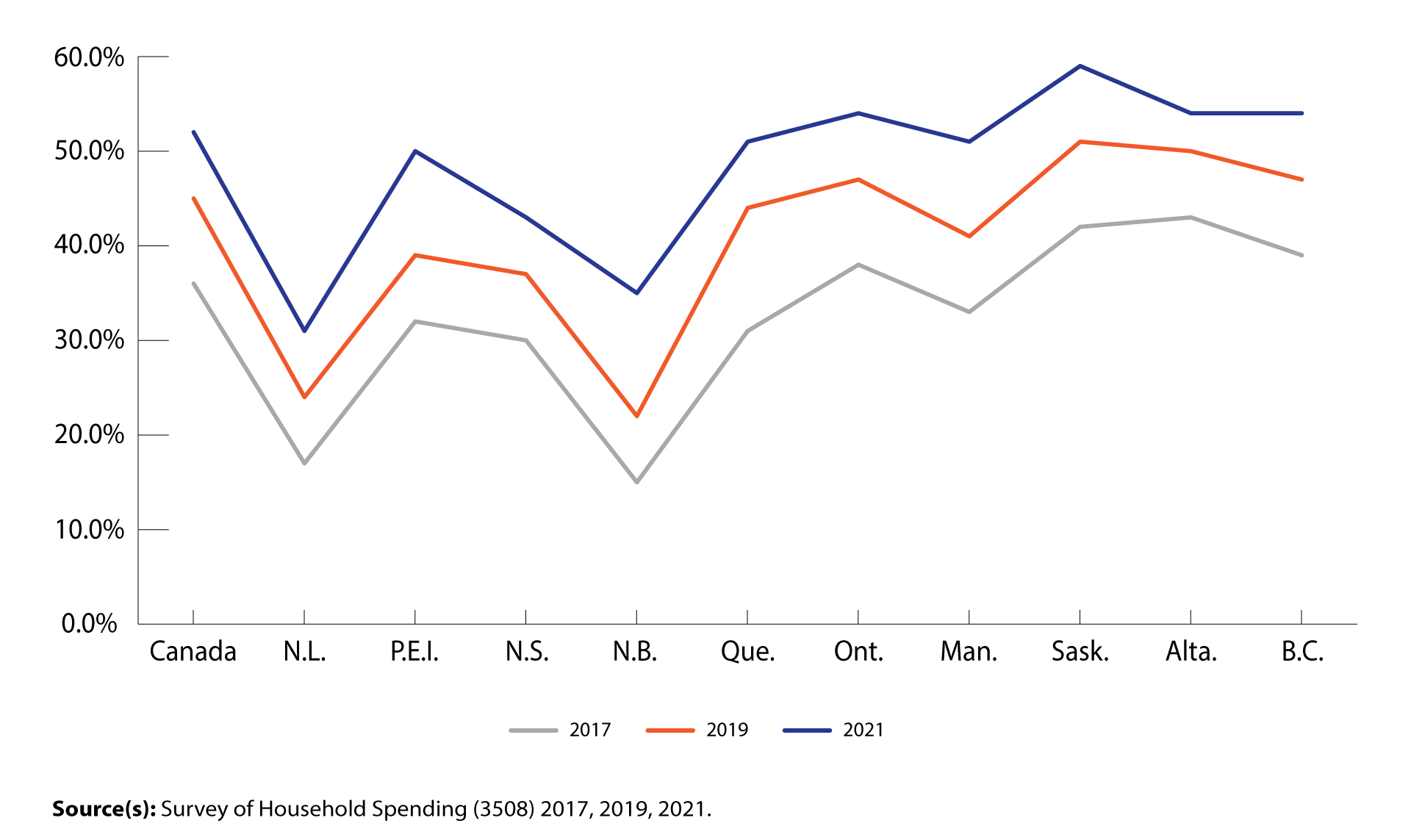
In recent years, cellphones have steadily continued to replace landline telephones in Canadian households to become the most popular telephone type. In 2021, 93.9% of Canadian households reported having at least one cellphone, compared with 91.3% in 2019 and 89.4% in 2017, according to the most recent data from the Survey of Household Spending.
Conversely, the share of households that reported having a landline has declined consistently, from nearly two-thirds (63.3%) in 2017 to less than half (47.4%) in 2021.
Cellphone use continued to increase across Canada during the pandemic
The share of Canadian households that reported having a cellphone but no landline increased from 35.7% in 2017 to 45.1% in 2019, rising to over half (52.2%) of households in 2021. This increase was widespread in all provinces from 2017 to 2021. During the COVID-19 pandemic, this percentage grew fastest in New Brunswick (from 22.1% in 2019 to 34.8% in 2021) and slowest in Alberta (from 50.4% to 53.5%).
Chart 1: Percentage of households with a cellular telephone but no landline, by province, 2017, 2019 and 2021

Description - Chart 1: Percentage of households with a cellular telephone but no landline, by province, 2017, 2019 and 2021
The title of the chart is “Percentage of households with a cellular telephone but no landline, by province, 2017, 2019 and 2021"
This is a line chart.
The vertical axis shows the percentage of households with a cellular telephone but no landline, by province, 2017, 2019 and 2021, from 0.0% to 60.0%, by increments of 10.0%.
The horizontal axis shows Canada and the provinces.
There are three series in this chart.
The first series is 2021. The lowest point in this line is 31.3% in Newfoundland and Labrador, and the highest point in this line is 59.5% in Saskatchewan.
The second series is 2019. The lowest point in this line is 22.1% in New Brunswick, and the highest point in this line is 51.0% in Saskatchewan.
The third series is 2017. The lowest point in this line is 15.4% in New Brunswick, and the highest point in this line is 42.8% in Alberta.
Source(s): Survey of Household Spending (3508) 2017, 2019, 2021.
Over 50% of households in Saskatchewan used only cellphones in both 2019 and 2021, the highest share among all provinces. By contrast, households in the Atlantic provinces had the lowest share for all three years, ranging from 15.4% in New Brunswick in 2017 to 31.3% in Newfoundland and Labrador in 2021.
Cellphone ownership increased fastest in the lowest income group in 2021
Cellular services became more affordable to Canadians in 2021, as consumers paid 26% less than in 2019. The share of households with cellphones grew in all income quintiles, led by 20% of households with the lowest income (from 76.2% in 2019 to 82.4% in 2021).
Next was the second quintile (from 88.3% to 91.9%). The big contributors to the growth were households with the lowest income level in Prince Edward Island (from 65.9% to 84.9%) and Newfoundland and Labrador (from 70.2% to 80.1%).
Number of cellphones varied by household type
From 2019 to 2021, the proportions of one-person households, couple households and lone-parent households that owned at least one cellphone all increased. One-person households observed the largest increase in cellphone ownership (from 79.4% in 2019 to 86.0% in 2021).
In terms of ownership by number of cellphones, one-person households reported the highest share of owning only one cellphone (84.2%), compared with all the other household types, and were the only type that experienced an increase from 2019.
In 2021, over half (54.5%) of couple households owned two cellphones, followed by lone-parent (50.5%) and other households (47.0%). One-person households, couple households and lone-parent households all reported an increase in the share of owning two cellphones.
The ownership share of three or more cellphones in 2021 was similar to that in 2019, led by other households (38.0%) and followed by couple households (32.7%) and lone-parent households (21.1%).
StatsCAN app
Did you know you can read StatsCAN Plus articles and more on the StatsCAN app? If you’re already using the app, let us know what you think by leaving a review in the Apple App Store and Google Play.
Contact information
For more information, contact the Statistical Information Service (toll-free 1-800-263-1136; 514-283-8300; infostats@statcan.gc.ca) or Media Relations (statcan.mediahotline-ligneinfomedias.statcan@statcan.gc.ca).

